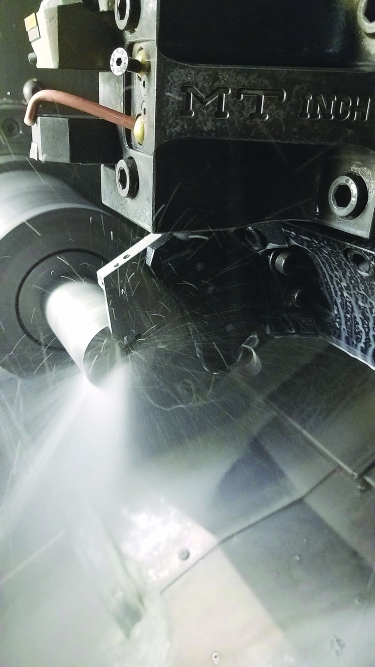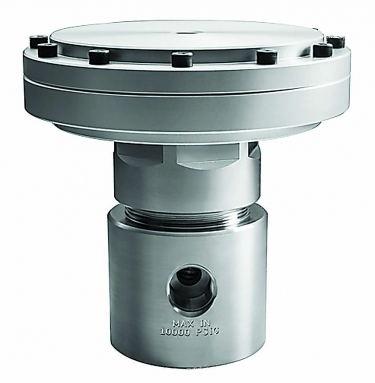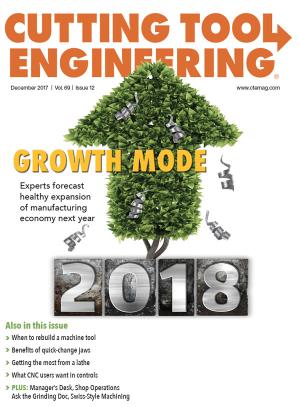END USER: Premier Industries, (763) 786-4020, www.premierind.us
SOLUTION PROVIDER: Horn USA Inc., (888) 818-HORN, www.hornusa.com
CHALLENGE: Reduce cycle times, extend tool life and impart finer surface finishes when parting off parts for pressure regulators.
SOLUTION: A modular toolholding system.
European parts manufacturers frequently apply metalcutting products in their own countries before those products leap the pond and land in the States. A recent example of that is Germany-based Hartmetall-Werkzeugfabrik Paul Horn GmbH’s modular grooving base holder system 960 for the grooving cassette system 845. System 960 consists of a base holder, or baseplate, that is machine-specific, with BMT, Mazak and VDI connections, as well as a height-adjustable grooving tool cassette holder, a cassette and a cutting insert that sits in the pocket on the cassette.
Premier Industries, Blaine, Minn., had a need for that toolholding system. The company produces pressure regulators and was experiencing slow cycle times, short tool life and rough surface finishes when parting off 2½"-dia. (63.5mm) parts with a 5.0mm-wide (0.197") grooving insert on four Eurotech twin-spindle, twin-turret lathes. The parts are primarily made of 316 stainless steel or aluminum.
Joe Haselbauer, production specialist for Premier, said he discussed the application with his Horn USA Inc. representative and tried some options before being informed about a new modular toolholding system that European manufacturers were having success with. Horn USA is based in Franklin, Tenn.

Premier Industries reduced cycle times, extended tool life and improved surface finishes when parting off after acquiring a modular toolholding system from Horn. Image courtesy of Horn USA.
“They were looking for someone in the U.S. market to give it a try, and we were definitely open to that because it was something we were looking for,” Haselbauer said.
He explained that on Premier’s machines, a toolholder typically mounts on the turret and a square-shank insert holder fits into that turret-mounted toolholder. Horn’s base holder, however, mounts to a turret, and the cassette system 845 mounts to the height-adjustable grooving tool cassette holder on the plate.
“You don’t have compression- or wedge-type fittings or anything like that to hold it together,” Haselbauer said. “Everything is bolted together, which really helps with rigidity. There are also a couple of alignment pins to make sure everything goes together square and straight.”
The modular grooving system 845 incorporates a baseplate that fits onto a turret via a base-mounted turret connection and is matched to the turret of the specific machine, Haselbauer added. According to Horn, the system also includes a height-adjustable grooving toolholder with an integrated coolant supply, a replaceable matching cartridge for various grooving widths and depths, and a grooving insert. The WOC range is from 1.2mm (0.047") to 4.0mm (0.157"), and the DOC range is from 17.0mm (0.669") to 55.0mm (2.165"). The system can part off material up to 110mm (4.330") in diameter.
To test the modular toolholding system, Premier first documented tool life, cycle time and surface finish when parting off different materials with its existing toolholding system, Haselbauer said. Next, the company ran the modular system at the same machining parameters used with its existing system.
“Right away, we saw great improvement in tool life,” he said. “Then we pushed the modular system as much as we felt we could and were able to achieve much better tool life and, at the same time, greatly reduced the cycle time.”
Chuck Wimer, operations manager at Premier, said cycle time went from 100 seconds to 35 seconds per part as the cutting speed went from 120 sfm (36.6 m/min.) to 350 sfm (106.7 m/min.). In addition, the surface finish improved from a range of 51 to 55 µin. Ra to 11 to 16 µin. Ra, and the variation in flatness improved from a range of 0.003" to 0.0035 (0.076mm to 0.089mm) to 0.0001" to 0.0003" (0.002mm to 0.008mm) across the part’s 2½" diameter.
“The parts are straight to under 0.001", so we are very pleased with these results,” Wimer said.
In addition, tool life increased from 25 to 75 parts per edge while reducing the cost per part from $4.30 to 91 cents, Wimer said. “This has had a huge impact on our operations and bottom line. We are vertically integrated, so after designing and producing the parts, we assemble and test them in our facilities. We’ve seen labor costs decrease in the downstream-assembly phase simply because we’re working with better parts.”

Premier Industries manufactures pressure regulators, such as this one, for a variety of industries. Image courtesy of Premier Industries.
Haselbauer added that because pressure regulators can be assembled faster than the parts can be machined, the shorter cycle time—combined with the reduction in machine stoppages to replace worn tools—means assemblers receive more parts per batch than previously. This increase in batch sizes enhances the efficiency of their assembly operations.
The machining operations are also more efficient because Premier no longer has to worry about an inconsistent surface finish after parting off, which frequently required leaving extra material on a part face that had to be removed with a turning tool to achieve the desired finish, Haselbauer said. “The new system is able to finish right to size. If we want to, we can create as fine a finish as our turning tools [can impart].”
In addition, the new modular toolholding system enables Premier to run its twin-spindle, twin-turret machines unattended for longer cycles—“sometimes hours at a time without an attendant having to go and check on a machine,” Haselbauer said.
Horn conducted a study of the application and determined that Premier would achieve a 9-month return on investment, based on Premier’s previous volume.
“At our current volume,” Haselbauer said, “we’re down to about a 4-month return on investment.” Premier produces 3,000 to 5,000 of the large-diameter parts annually, he noted.
The ability to consistently meet customer needs is important to customer relationships, considering the “better, faster, cheaper” attitude prevalent in manufacturing. “The shorter cycle times and longer tool life that we get from the Horn system drove higher part volumes,” Wimer said. “And, combined with increased part quality and consistency, we’ve become even more important to our customers.”
Related Glossary Terms
- chuck
chuck
Workholding device that affixes to a mill, lathe or drill-press spindle. It holds a tool or workpiece by one end, allowing it to be rotated. May also be fitted to the machine table to hold a workpiece. Two or more adjustable jaws actually hold the tool or part. May be actuated manually, pneumatically, hydraulically or electrically. See collet.
- coolant
coolant
Fluid that reduces temperature buildup at the tool/workpiece interface during machining. Normally takes the form of a liquid such as soluble or chemical mixtures (semisynthetic, synthetic) but can be pressurized air or other gas. Because of water’s ability to absorb great quantities of heat, it is widely used as a coolant and vehicle for various cutting compounds, with the water-to-compound ratio varying with the machining task. See cutting fluid; semisynthetic cutting fluid; soluble-oil cutting fluid; synthetic cutting fluid.
- cutting speed
cutting speed
Tangential velocity on the surface of the tool or workpiece at the cutting interface. The formula for cutting speed (sfm) is tool diameter 5 0.26 5 spindle speed (rpm). The formula for feed per tooth (fpt) is table feed (ipm)/number of flutes/spindle speed (rpm). The formula for spindle speed (rpm) is cutting speed (sfm) 5 3.82/tool diameter. The formula for table feed (ipm) is feed per tooth (ftp) 5 number of tool flutes 5 spindle speed (rpm).
- grooving
grooving
Machining grooves and shallow channels. Example: grooving ball-bearing raceways. Typically performed by tools that are capable of light cuts at high feed rates. Imparts high-quality finish.
- land
land
Part of the tool body that remains after the flutes are cut.
- metalcutting ( material cutting)
metalcutting ( material cutting)
Any machining process used to part metal or other material or give a workpiece a new configuration. Conventionally applies to machining operations in which a cutting tool mechanically removes material in the form of chips; applies to any process in which metal or material is removed to create new shapes. See metalforming.
- parting
parting
When used in lathe or screw-machine operations, this process separates a completed part from chuck-held or collet-fed stock by means of a very narrow, flat-end cutting, or parting, tool.
- sawing machine ( saw)
sawing machine ( saw)
Machine designed to use a serrated-tooth blade to cut metal or other material. Comes in a wide variety of styles but takes one of four basic forms: hacksaw (a simple, rugged machine that uses a reciprocating motion to part metal or other material); cold or circular saw (powers a circular blade that cuts structural materials); bandsaw (runs an endless band; the two basic types are cutoff and contour band machines, which cut intricate contours and shapes); and abrasive cutoff saw (similar in appearance to the cold saw, but uses an abrasive disc that rotates at high speeds rather than a blade with serrated teeth).
- toolholder
toolholder
Secures a cutting tool during a machining operation. Basic types include block, cartridge, chuck, collet, fixed, modular, quick-change and rotating.
- turning
turning
Workpiece is held in a chuck, mounted on a face plate or secured between centers and rotated while a cutting tool, normally a single-point tool, is fed into it along its periphery or across its end or face. Takes the form of straight turning (cutting along the periphery of the workpiece); taper turning (creating a taper); step turning (turning different-size diameters on the same work); chamfering (beveling an edge or shoulder); facing (cutting on an end); turning threads (usually external but can be internal); roughing (high-volume metal removal); and finishing (final light cuts). Performed on lathes, turning centers, chucking machines, automatic screw machines and similar machines.
END USER: Premier Industries, (763) 786-4020, www.premierind.us
SOLUTION PROVIDER: Horn USA Inc., (888) 818-HORN, www.hornusa.com
CHALLENGE: Reduce cycle times, extend tool life and impart finer surface finishes when parting off parts for pressure regulators.
SOLUTION: A modular toolholding system.

